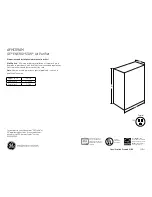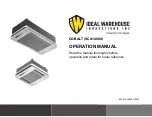
39
OCH670
Check code
Abnormal points and detection method
Judgment and action
Case
UP
(4210)
Compressor overcurrent interruption
Abnormal if overcurrent DC bus or com-
pressor is detected after compressor starts
operating for 30 seconds.
1
Stop valve of outdoor unit is
closed.
2
Decrease of power supply voltage
3
Looseness, disconnection or
converse of compressor wiring
connection
4
Defective fan of indoor/outdoor
units
5
Short cycle of indoor/outdoor
units
6
Defective input circuit of
outdoor controller board
7
Defective compressor
8
Defective outdoor power circuit
board
9
Dip switch setting difference of
outdoor controller circuit board
1
Open stop valve.
2
Check facility of power supply.
3
Correct the wiring (U
•
V
•
W phase) to compres-
sor. Refer to "9-9. TEST POINT DIAGRAM
(Outdoor power circuit board)".
4
Check indoor/outdoor fan.
5
Solve short cycle.
6
Replace outdoor controller circuit board.
7
Check compressor. Refer to "9-6. HOW TO
CHECK THE PARTS".
● Before the replacement of the outdoor controller
circuit board, disconnect the wiring to compressor
from the outdoor power circuit board and check the
output voltage among phases, U, V, W, during test
run. No defect on board if voltage among phases
(U-V, V-W and W-U) is same. Make sure to perform
the voltage check with same performing frequency.
8
Replace outdoor power circuit board
9
Check the dip switch setting of outdoor con-
troller circuit board
E0
or
E4
Remote controller transmission error
(E0)/signal receiving error (E4)
1
Abnormal if main or sub remote control-
ler cannot receive normally any trans-
mission from indoor unit of refrigerant
address “0” for 3 minutes.
(Check code : E0)
2
Abnormal if sub remote controller could
not receive any signal for 2 minutes.
(Check code: E0)
1
Abnormal if indoor controller board
cannot receive normally any data from
remote controller board or from other
indoor controller board for 3 minutes.
(Check code: E4)
2
Indoor controller board cannot receive
any signal from remote controller for 2
minutes. (Check code: E4)
1
Check disconnection or looseness of indoor
unit or transmission wire of remote controller.
2
Set one of the remote controllers “main” if
there is no problem with the action above.
3
Check wiring of remote controller.
• Total wiring length: Max. 500m
(Do not use cable
o
3 or more.)
• The number of connecting indoor units:
Max. 16 units
•
The number of connecting remote controller:
Max. 2 units
When it is not the above-mentioned problem of
1
–
3
4
Diagnose remote controllers.
a) When “RC OK” is displayed, remote controllers
have no problem. Turn the power off, and on
again to check. If abnormality generates again,
replace indoor controller board.
b) When “RC NG” is displayed, replace
remote controller.
c) When “RC E3” or “ERC 00-66” is dis-
played, noise may be causing abnormality.
Note:
If the unit is not normal after replacing indoor
controller board in group control, indoor controller
board of address “0” may be abnormal.
1
Contact failure at transmission
wire of remote controller
2
All remote controllers are set
as “sub” remote controller.
In this case, E0 is displayed
on remote controller, and E4
is displayed at LED (LED1,
LED2) on the outdoor controller
circuit board.
3
Miswiring of remote controller
4
Defective transmitting receiving
circuit of remote controller
5
Defective transmitting receiv-
ing circuit of indoor controller
board of refrigerant address “0”
6
Noise has entered into the
transmission wire of remote
controller.
E1
or
E2
Remote controller control board
1
Abnormal if data cannot be normally
read from the nonvolatile memory of the
remote controller control board.
(Check code: E1)
2
Abnormal if the clock function of remote
controller cannot be normally operated.
(Check code: E2)
1
Defective remote controller
1
Replace remote controller.
















































